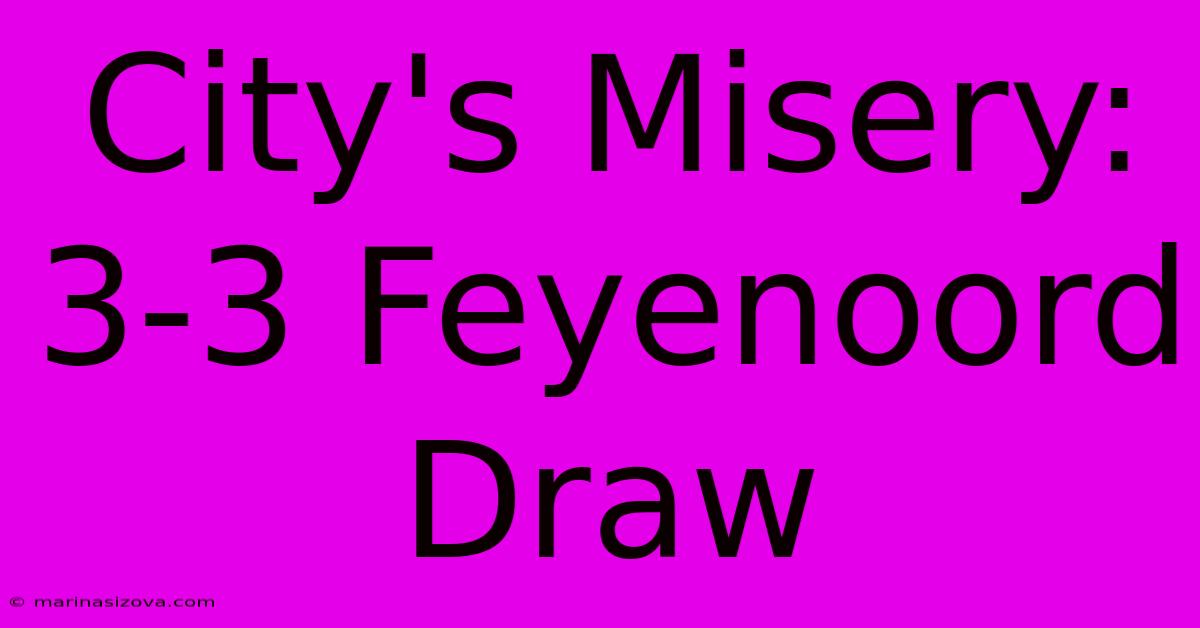City's Misery: 3-3 Feyenoord Draw

Discover more detailed and exciting information on our website. Click the link below to start your adventure: Visit Best Website. Don't miss out!
Table of Contents
City's Misery: Unpacking the 3-3 Feyenoord Draw
Is a 3-3 draw against Feyenoord a sign of underlying issues, or just a bad day at the office? This dramatic encounter reveals crucial insights into Manchester City's current form. Editor's Note: Analysis of the thrilling 3-3 draw between Manchester City and Feyenoord has been published today. Understanding this match is vital for fans and analysts alike, offering a glimpse into the team's strengths and weaknesses as the season progresses. This comprehensive review explores tactical decisions, individual performances, and the overall implications of this high-scoring encounter.
Analysis: This analysis delves deep into match statistics, player performances, and tactical approaches employed by both teams. We meticulously examined post-match interviews, expert commentary, and in-depth game footage to provide a balanced perspective on this rollercoaster game. The goal is to offer a clear and insightful understanding of the events that led to the 3-3 scoreline, helping readers to interpret the outcome accurately.
| Key Insights from the City-Feyenoord Match | Details |
|---|---|
| Defensive Vulnerabilities | Exposed high defensive line; midfield gaps |
| Attacking Prowess | Clinical finishing, but inconsistent chances |
| Tactical Flexibility | Adjustments needed during the match |
| Individual Player Performances | Key players underperformed; others excelled |
| Overall Team Cohesion | Occasional lapses in communication |
City's Misery: A Deeper Dive
Defensive Vulnerabilities
Introduction: The match highlighted concerning defensive frailties within Manchester City's backline. The high defensive line, a hallmark of their usual strategy, was repeatedly exploited by Feyenoord's quick attackers.
Facets:
- High Line Exploitation: Feyenoord successfully used through balls to bypass City's high line, leading to several scoring opportunities.
- Midfield Gaps: The midfield lacked the necessary compactness, leaving spaces for Feyenoord to penetrate.
- Individual Errors: Several individual defensive errors contributed to the conceded goals.
- Risk and Mitigation: The high line is inherently risky, requiring exceptional coordination and speed. Mitigation strategies like deeper positioning or adjusting the press could be considered.
- Impact and Implications: The conceded goals demonstrate a need for defensive solidity and tactical adjustments.
Summary: The defensive lapses weren't simply isolated incidents; they indicated a systematic problem in the team's defensive setup and coordination. Addressing these vulnerabilities is crucial for future success.
Attacking Prowess
Introduction: Despite the defensive shortcomings, Manchester City showcased their remarkable attacking potential throughout the match. However, the effectiveness of their attack wasn't consistently maintained.
Facets:
- Clinical Finishing: City's clinical finishing abilities were evident in their three goals.
- Chance Creation: The team created multiple scoring opportunities, although not at a consistent rate.
- Ball Possession: City dominated possession, indicating superior control of the match.
- Attack Transitions: Transitioning between defense and attack was occasionally slow, hindering swift counter-attacks.
- Creative Midfield Play: The creative midfield play produced several crucial passes, showcasing individual brilliance.
Summary: While City displayed considerable attacking firepower, achieving consistent scoring opportunities remains a priority. Improving transition play could enhance overall effectiveness.
FAQ: Manchester City vs. Feyenoord
Introduction: This section addresses frequently asked questions about the match.
Questions and Answers:
- Q: What were the key moments of the game? A: The opening goal, two quick Feyenoord goals, City's comeback, and the late equalizer were crucial turning points.
- Q: How did the managers react to the outcome? A: Post-match interviews revealed varying levels of concern and emphasis on areas for improvement.
- Q: What are the implications for the future? A: This draw highlights defensive vulnerabilities and the need for consistent attacking prowess.
- Q: How did individual players perform? A: Some key players underperformed, while others delivered exceptional performances, showcasing individual strengths and weaknesses.
- Q: What tactical changes might City make? A: Potential adjustments could involve lowering the defensive line, improving midfield compactness, and sharpening transition play.
- Q: What were the main tactical differences between the two teams? A: Feyenoord employed a more direct approach, while City emphasized possession-based play.
Tips for Improving City's Performance
Introduction: This section offers tips for enhancing future performances.
Tips:
- Lower the Defensive Line: Reduce risk of being exploited on through balls.
- Compact Midfield: Minimize space for opposing attackers.
- Improve Transition Play: Enhance the speed of transitioning between defense and attack.
- Consistent Attacking Pressure: Maintain pressure to create more consistent scoring opportunities.
- Strengthen Defensive Communication: Improve coordination between defenders and midfielders.
- Individual Player Improvement: Focus on honing individual skills to optimize team performance.
Summary: Implementing these improvements will enhance both defensive solidity and attacking efficiency, significantly impacting future results.
Conclusion: A Wake-Up Call for Manchester City
Recap: The 3-3 draw against Feyenoord served as a stark reminder of Manchester City's defensive frailties, while simultaneously showcasing their potent attacking capabilities. The match unveiled inconsistencies in both attack and defense, highlighting the need for improvements.
Closing Thoughts: Addressing the defensive vulnerabilities and maintaining consistent attacking pressure are crucial for maintaining competitiveness. While the result was disappointing, the match provides valuable lessons for future improvement. Further analysis and strategic adjustments are vital to secure consistent victories throughout the season.

Thank you for visiting our website wich cover about City's Misery: 3-3 Feyenoord Draw. We hope the information provided has been useful to you. Feel free to contact us if you have any questions or need further assistance. See you next time and dont miss to bookmark.
Featured Posts
-
Paris Neves Impressionne
Nov 27, 2024
-
City Cede Empate Ao Feyenoord
Nov 27, 2024
-
Idc Announces 2024 Asia Pacific Winners
Nov 27, 2024
-
Resultados Champions Jornada 5
Nov 27, 2024
-
Ucl 2024 25 Bar 3 0 Highlights
Nov 27, 2024
